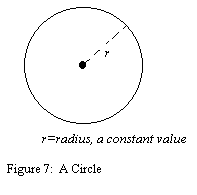Circles
| Philosophy of Mathematics |
While creating a resource page, please click here for a resource creation checklist.
Concept Map
Error: Mind Map file circle.mm not found
Textbook
ncert books
Class 9 Mathematics contain simple description and theorems on circles. 9 Mathematics contain higher level description and theorems on circles.
Additional Information
Useful websites
- maths is fun A GOOD WEBSITE ON DEFINITIONS FOR CIRCLES
- COOL MATH GIVES CLEAR AND EASY DEFINITIONS
- OPEN REFERENCE CONTAINS FEW SIMULATIONS
- WIKIPEDIA CONTAINS EXPLANATIONS FOR CIRCLES
- KHAN ACADEMY CONTAIN GOOD VIDEOS
- ARVIND GUPTA TOYS CONTAIN VERY GOOD BOOKS ON MATHEMATICS AND SCIENCE
- nrich.maths.org Contain very good description of Pie
Reference Books
- School Geometry By Hall and Stevens. Part3 pageno 143. Contains basic definitions and proofs given by Euclid.
Teaching Outlines
Introduction
Concept #1 CIRCLE
Notes for teachers
Introduction: The circle is the most primitive and rudimentary of all human inventions, and at the same time, the most dynamic. It is the cornerstone in the foundation of science and technology. It is the basic tool of all engineers and designers. It is used by the greatest artists and architects in the history of mankind.
Without a circular shape the wheel, pulleys, gears, ball bearings and a thousand other items we take for granted wouldn’t exist. And of course we would never have the pleasure of driving a car, riding a giant wheel, or watching the moon landing on our television set.
If you look through any old patent claim, you will most likely find the repeated use of circles, spheres, curves, arches, etc. circles are everything and they are nothing. They don’t exist in reality and yet they are the basis of all that mankind has brought into existence. That is why a circle is so fantastic.
Learning objectives
- Appreciation of circle as an important shape as it is an intrical component in the invention of almost everything that we see around us.
- To make students know that circle is a 2-dimensional plane circular figure.
- All points on its edge are equidistant from the center.
- The method of drawing a circle
- The size of the circle is defined by its radius.
- To elicit the difference between a bangle or a circular ring and circle as such.
Activity No #1 Circle of varying radius using Geogebra
- Estimated Time: 20 mins
- Materials/ Resources needed: Laptop, geogebra,projector and a pointer
- Prerequisites/Instructions, if any:
- The students should know a circle
- They should know the meaning of radius .
- They should know to measure radius using compass
- They should know to draw a circle of given radius using compass.
- Multimedia resources: Laptop
- Website interactives/ links/ / Geogebra Applets:
- Process:
- Review the terms plane closed figures, circle and radius.
- Show them how to measure radius on the compass
- Show them to draw a circle.
- Project the geogebra and let them view the changing size of the circle with changing radius.
- Developmental Questions:
- What is a circle ?
- Which point is the centre of the circle ?
- What is the radius of this circle ?
- How do you name the radius ?
- Evaluation:
- By what parameter is the size of a circle defined ?
- Bigger the radius, _____________ is the size of the circle.
- Question Corner:
- How do you name a circle ?
- Can you draw a circle without knowing the radius ?
Activity No #
- Estimated Time
- Materials/ Resources needed
- Prerequisites/Instructions, if any
- Multimedia resources
- Website interactives/ links/ / Geogebra Applets
- Process/ Developmental Questions
- Evaluation
- Question Corner
Concept #
Learning objectives
Notes for teachers
Activity No # Is circle a Polygon ?
- Estimated Time: 40 minutes
*Materials/ Resources needed
Laptop, geogebra file, projector and a pointer.
- Prerequisites/Instructions, if any
- The students should know that the plane figures with 3 or more than 3 sides are called polygons.
- They should know that as the number of sides increases, the figure and hence its name also changes.
- They should know the basics of a circle.
*Multimedia resources Laptop
- Website interactives/ links/ / Geogebra Applets
- Process
- Ask the students what polygons are ?
- As you increase the number of sides ask them to count the number of sides.
- Ask them the name of the shape formed.
- As the number of sides increase,let them speak about the length of the sides ?
*Developmental Questions
- How many sides does this figure have ?
- Name the figure formed.
- What is hapenning to the length of the sides as the number of sides is increased ?
- What shape is this ?
- So, can circle be considered a polygon ? Justify
- Evaluation:
- Are the students able to comprehend that the number of sides is getting infinite as the shape resembles a circle ?
- Are the students able to appreciate the application of polygon anology to circles.
- Question Corner
Debate between two groups with these two perspectives.
- Circle seems to have derived from polygons . Circle can be considered a polygon.
Vs
- A polygon is defined by a certain number of sides having non zero length. Then how can circle be a polygon ? (hint: all radii in a circle should be equal ???)
Activity No #
- Estimated Time
- Materials/ Resources needed
- Prerequisites/Instructions, if any
- Multimedia resources
- Website interactives/ links/ / Geogebra Applets
- Process/ Developmental Questions
- Evaluation
- Question Corner
Hints for difficult problems
Project Ideas
Math Fun
Usage
Create a new page and type {{subst:Math-Content}} to use this template
